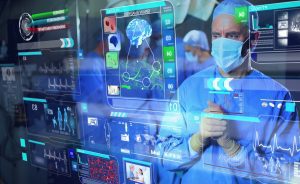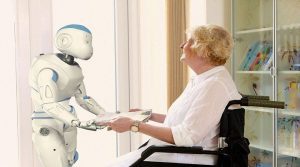Robotics has transformed how we tackle work in a variety of industries in recent years, particularly in manufacturing and healthcare. Artificial intelligence (AI) and machine learning-driven advanced robotics have created previously unheard-of efficiencies and capabilities, spurring development and innovation. This article examines how robotics is changing different industries, highlighting important advantages and using real-life examples
Robotics has transformed how we tackle work in a variety of industries in recent years, particularly in manufacturing and healthcare. Artificial intelligence (AI) and machine learning-driven advanced robotics have created previously unheard-of efficiencies and capabilities, spurring development and innovation. This article examines how robotics is changing different industries, highlighting important advantages and using real-life examples to demonstrate how robotics is changing the world.
The Evolution of Robotics: A Technological Leap

Image by Yandex.com
The term robotics traditionally referred to the automation of simple tasks, but advancements in technology have expanded its scope to complex problem-solving and adaptive learning. In manufacturing, robotics can now handle intricate processes such as assembling delicate components, quality assurance, and material handling. Similarly, in healthcare, robotics supports surgical precision, patient care, and data-driven diagnostics.
Today’s advanced robots integrate AI, machine learning, IoT (Internet of Things), and big data to achieve levels of functionality that seemed impossible a decade ago. This evolution has allowed robots to become more efficient, versatile, and essential in industries that rely heavily on both precision and efficiency.
Robotics in Manufacturing: Enhancing Productivity and Quality
Benefits of Robotics in Manufacturing
- Increased Productivity: Robots can work around the clock without fatigue, drastically increasing production rates.
- Enhanced Precision: With advanced sensors and AI, robots achieve high levels of precision, reducing human error.
- Cost Efficiency: Although initial investment can be high, robots save on labor costs and reduce waste, offering long-term financial benefits.
- Improved Safety: Robots handle hazardous tasks, reducing workplace injuries and ensuring worker safety.
Case Study: Tesla’s Robotic Assembly Lines
Tesla, a leader in the automotive industry, has harnessed robotics to streamline its manufacturing process. Its Gigafactory uses robots for nearly every step of vehicle production, from body assembly to painting. Tesla’s robots have led to faster production rates and high-quality vehicles while maintaining safety and efficiency standards. By utilizing robotics, Tesla has been able to scale up production and meet growing demand while staying competitive in a challenging market.
Example: Robotic Arms in Electronics Manufacturing
In electronics, robotic arms have become indispensable, especially in assembling delicate components. Companies like Foxconn—an Apple supplier—use robots to assemble circuit boards and other components with precision that would be difficult for human hands to replicate. Robotic arms can also inspect and sort components, ensuring consistency in quality and reducing faulty products.
Robotics in Healthcare: Revolutionizing Patient Care
Benefits of Robotics in Healthcare
- Enhanced Surgical Precision: Robotics assists surgeons in performing complex surgeries with minimal incisions, improving patient outcomes and reducing recovery times.
- Efficient Patient Care: Robots aid in routine tasks like medication delivery, sanitation, and monitoring vital signs, allowing healthcare workers to focus on critical care.
- Improved Diagnostics: Robotics, combined with AI, helps in analyzing medical data, leading to quicker and more accurate diagnoses.
- Remote and Telepresence Surgery: Robotics allows for surgeries and consultations across distances, making healthcare accessible to remote areas.
Case Study: The da Vinci Surgical System
One of the most renowned advancements in robotic surgery is the da Vinci Surgical System, which assists surgeons in performing precise, minimally invasive procedures. This system provides high-definition, 3D imaging, and enhanced dexterity, allowing surgeons to execute complex tasks with greater control. The da Vinci system has been instrumental in prostatectomies, heart surgeries, and other delicate operations, significantly reducing complications and recovery times for patients.
Example: Robotics in Rehabilitation
Robotics is also transforming rehabilitation therapy. Exoskeletons, such as those developed by Ekso Bionics, aid individuals recovering from stroke or spinal injuries by providing support and enabling movement during therapy sessions. These exoskeletons assist in muscle activation and balance, helping patients regain strength and mobility in a shorter timeframe compared to traditional therapy methods.
Challenges and Considerations in Robotics Integration

Image by Yandex.com
While robotics brings many advantages, it also poses certain challenges:
- High Initial Costs: The cost of implementing robotics technology can be prohibitive, especially for small and medium-sized enterprises.
- Training and Skills Gap: Workers need specialized training to operate and maintain robotics systems, requiring investment in workforce education.
- Job Displacement Concerns: There is ongoing debate about robotics and automation leading to job loss, as machines take on roles traditionally filled by humans.
- Ethical and Privacy Issues: In healthcare, robotics can raise concerns around patient privacy and data security, especially with systems that collect sensitive information.
Addressing these challenges involves creating a balance between technology and human involvement, as well as developing policies that safeguard jobs while promoting innovation.
Future Outlook: What’s Next for Robotics?
Expanding Roles in Manufacturing
With advancements in AI, the future of robotics in manufacturing looks promising. Robots are expected to take on more complex roles, such as predictive maintenance, where AI-powered robots will analyze machinery for signs of wear and tear, reducing downtime. This integration will improve productivity and streamline processes further, creating a manufacturing environment where humans and robots work in close collaboration.
Transformative Potential in Healthcare
In healthcare, robotics will likely expand into elder care and mental health support. Robotic caregivers, for example, are already in development to assist the elderly with daily activities and provide companionship. AI-driven diagnostic robots could further assist doctors in identifying diseases early and creating personalized treatment plans, revolutionizing preventive healthcare.
Conclusion
The impact of advanced robotics on manufacturing and healthcare demonstrates the vast potential of technology to improve efficiency, quality, and accessibility. Robotics has not only made processes faster and more precise but also safer and more reliable. By continuing to invest in robotics technology, industries can pave the way for innovations that transform how we work, heal, and live.
As robotics technology evolves, it is vital to address associated challenges responsibly, ensuring that the benefits reach as many people as possible without unintended negative consequences. The journey of robotics has only just begun, and its influence on manufacturing and healthcare will undoubtedly continue to grow, driving positive changes for years to come.





















